Mixing Uncertainties in Low-Metallicity AGB Stars: The Impact on Stellar Structure and Nucleosynthesis
Abstract
1. Introduction
2. Computational Methods
3. Results
3.1. Description of the Stellar Models
3.2. Postprocessing Nucleosynthesis Calculations
4. Conclusions
Author Contributions
Funding
Institutional Review Board Statement
Informed Consent Statement
Data Availability Statement
Acknowledgments
Conflicts of Interest
References
- Cameron, A.G.W. Nuclear Reactions in Stars and Nucleogenesis. Publ. Astron. Soc. Pac. 1957, 69, 201. [Google Scholar] [CrossRef]
- Burbidge, E.M.; Burbidge, G.R.; Fowler, W.A.; Hoyle, F. Synthesis of the Elements in Stars. Rev. Mod. Phys. 1957, 29, 547–650. [Google Scholar] [CrossRef]
- Gallino, R.; Arlandini, C.; Busso, M.; Lugaro, M.; Travaglio, C.; Straniero, O.; Chieffi, A.; Limongi, M. Evolution and Nucleosynthesis in Low-Mass Asymptotic Giant Branch Stars. II. Neutron Capture and the s-Process. Astrophys. J. 1998, 497, 388. [Google Scholar] [CrossRef]
- Käppeler, F.; Gallino, R.; Bisterzo, S.; Aoki, W. The s process: Nuclear physics, stellar models, and observations. Rev. Mod. Phys. 2011, 83, 157–194. [Google Scholar] [CrossRef]
- Ulrich, R.K. The s-Process in Stars. In Explosive Nucleosynthesis; Schramm, D.N., Arnett, W.D., Eds.; University of Texas Press: Austin, TX, USA; London, UK, 1973; p. 139. [Google Scholar]
- Iben, I., Jr.; Renzini, A. Asymptotic giant branch evolution and beyond. Annu. Rev. Astron. Astrophys. 1983, 21, 271–342. [Google Scholar] [CrossRef]
- Clayton, D.D.; Rassbach, M.E. Termination of the s-PROCESS. Astrophys. J. 1967, 148, 69. [Google Scholar] [CrossRef]
- Travaglio, C.; Gallino, R.; Busso, M.; Gratton, R. Lead: Asymptotic Giant Branch Production and Galactic Chemical Evolution. Astrophys. J. 2001, 549, 346–352. [Google Scholar] [CrossRef]
- Bisterzo, S.; Gallino, R.; Käppeler, F.; Wiescher, M.; Imbriani, G.; Straniero, O.; Cristallo, S.; Görres, J.; deBoer, R.J. The branchings of the main s-process: Their sensitivity to α-induced reactions on 13C and 22Ne and to the uncertainties of the nuclear network. Mon. Not. R. Astron. Soc. 2015, 449, 506–527. [Google Scholar] [CrossRef]
- Denissenkov, P.A.; Tout, C.A. Partial mixing and formation of the 13C pocket by internal gravity waves in asymptotic giant branch stars. Mon. Not. R. Astron. Soc. 2003, 340, 722–732. [Google Scholar] [CrossRef]
- Straniero, O.; Gallino, R.; Busso, M.; Chiefei, A.; Raiteri, C.M.; Limongi, M.; Salaris, M. Radiative C-13 burning in asymptotic giant branch stars and s-processing. Astrophys. J. 1995, 440, L85–L87. [Google Scholar] [CrossRef]
- Herwig, F.; Blöcker, T.; Schönberner, D.; El Eid, M.F. Stellar evolution of low and intermediate-mass stars. IV. Hydrodynamically-based overshoot and nucleosynthesis in AGB stars. Astron. Astrophys. 1997, 324, L81–L84. [Google Scholar]
- Langer, N.; Heger, A.; Wellstein, S.; Herwig, F. Mixing and nucleosynthesis in rotating AGB stars. Astron. Astrophys. 1999, 346, L37–L40. [Google Scholar]
- Den Hartogh, J.W.; Hirschi, R.; Lugaro, M.; Doherty, C.L.; Battino, U.; Herwig, F.; Pignatari, M.; Eggenberger, P. The s process in rotating low-mass AGB stars. Nucleosynthesis calculations in models matching asteroseismic constraints. Astron. Astrophys. 2019, 629, A123. [Google Scholar] [CrossRef]
- Ulrich, R.K. Thermohaline Convection in Stellar Interiors. Astrophys. J. 1972, 172, 165. [Google Scholar] [CrossRef]
- Kippenhahn, R.; Ruschenplatt, G.; Thomas, H.C. The time scale of thermohaline mixing in stars. Astron. Astrophys. 1980, 91, 175–180. [Google Scholar]
- Brown, J.M.; Garaud, P.; Stellmach, S. Chemical Transport and Spontaneous Layer Formation in Fingering Convection in Astrophysics. Astrophys. J. 2013, 768, 34. [Google Scholar] [CrossRef]
- Traxler, A.; Stellmach, S.; Garaud, P.; Radko, T.; Brummell, N. Dynamics of fingering convection. Part 1 Small-scale fluxes and large-scale instabilities. J. Fluid Mech. 2011, 677, 530–553. [Google Scholar] [CrossRef]
- Garaud, P.; Medrano, M.; Brown, J.M.; Mankovich, C.; Moore, K. Excitation of Gravity Waves by Fingering Convection, and the Formation of Compositional Staircases in Stellar Interiors. Astrophys. J. 2015, 808, 89. [Google Scholar] [CrossRef]
- Trippella, O.; Busso, M.; Palmerini, S.; Maiorca, E.; Nucci, M.C. s-Processing in AGB Stars Revisited. II. Enhanced 13C Production through MHD-induced Mixing. Astrophys. J. 2016, 818, 125. [Google Scholar] [CrossRef]
- Nucci, M.C.; Busso, M. Magnetohydrodynamics and Deep Mixing in Evolved Stars. I. Two- and Three-dimensional Analytical Models for the Asymptotic Giant Branch. Astrophys. J. 2014, 787, 141. [Google Scholar] [CrossRef][Green Version]
- Vescovi, D.; Cristallo, S.; Busso, M.; Liu, N. Magnetic-buoyancy-induced Mixing in AGB Stars: Presolar SiC Grains. Astrophys. J. Lett. 2020, 897, L25. [Google Scholar] [CrossRef]
- Nordhaus, J.; Blackman, E.G.; Frank, A. Isolated versus common envelope dynamos in planetary nebula progenitors. Mon. Not. R. Astron. Soc. 2007, 376, 599–608. [Google Scholar] [CrossRef]
- Kawka, A. The properties and origin of magnetic fields in white dwarfs. Contrib. Astron. Obs. Skaln. Pleso 2018, 48, 228–235. [Google Scholar]
- Battino, U.; Pignatari, M.; Ritter, C.; Herwig, F.; Denisenkov, P.; Den Hartogh, J.W.; Trappitsch, R.; Hirschi, R.; Freytag, B.; Thielemann, F.; et al. Application of a Theory and Simulation-based Convective Boundary Mixing Model for AGB Star Evolution and Nucleosynthesis. Astrophys. J. 2016, 827, 30. [Google Scholar] [CrossRef]
- Battino, U.; Tattersall, A.; Lederer-Woods, C.; Herwig, F.; Denissenkov, P.; Hirschi, R.; Trappitsch, R.; den Hartogh, J.W.; Pignatari, M.; NuGrid Collaboration. NuGrid stellar data set—III. Updated low-mass AGB models and s-process nucleosynthesis with metallicities Z= 0.01, Z = 0.02, and Z = 0.03. Mon. Not. R. Astron. Soc. 2019, 489, 1082–1098. [Google Scholar] [CrossRef]
- Adsley, P.; Battino, U.; Best, A.; Caciolli, A.; Guglielmetti, A.; Imbriani, G.; Jayatissa, H.; La Cognata, M.; Lamia, L.; Masha, E.; et al. Reevaluation of the 22Ne(α,γ)26Mg and 22Ne(α,n)25Mg reaction rates. Phys. Rev. C 2021, 103, 015805. [Google Scholar] [CrossRef]
- Ota, S.; Christian, G.; Lotay, G.; Catford, W.N.; Bennett, E.A.; Dede, S.; Doherty, D.T.; Hallam, S.; Hooker, J.; Hunt, C.; et al. Decay properties of 22Ne + α resonances and their impact on s-process nucleosynthesis. Phys. Lett. B 2020, 802, 135256. [Google Scholar] [CrossRef]
- Piersanti, L.; Cristallo, S.; Straniero, O. The Effects of Rotation on s-process Nucleosynthesis in Asymptotic Giant Branch Stars. Astrophys. J. 2013, 774, 98. [Google Scholar] [CrossRef]
- Liu, N.; Savina, M.R.; Gallino, R.; Davis, A.M.; Bisterzo, S.; Gyngard, F.; Käppeler, F.; Cristallo, S.; Dauphas, N.; Pellin, M.J.; et al. Correlated Strontium and Barium Isotopic Compositions of Acid-cleaned Single Mainstream Silicon Carbides from Murchison. Astrophys. J. 2015, 803, 12. [Google Scholar] [CrossRef]
- Palmerini, S.; Trippella, O.; Busso, M.; Vescovi, D.; Petrelli, M.; Zucchini, A.; Frondini, F. s-Processing from MHD-induced mixing and isotopic abundances in presolar SiC grains. Geochim. Cosmochim. Acta 2018, 221, 21–36. [Google Scholar] [CrossRef]
- Liu, N.; Stephan, T.; Cristallo, S.; Gallino, R.; Boehnke, P.; Nittler, L.R.; O’D. Alexander, C.M.; Davis, A.M.; Trappitsch, R.; Pellin, M.J.; et al. Presolar Silicon Carbide Grains of Types Y and Z: Their Molybdenum Isotopic Compositions and Stellar Origins. Astrophys. J. 2019, 881, 28. [Google Scholar] [CrossRef]
- Herwig, F.; Freytag, B.; Fuchs, T.; Hansen, J.P.; Hueckstaedt, R.M.; Porter, D.H.; Timmes, F.X.; Woodward, P.R. Convective and Non-Convective Mixing in AGB Stars. In Why Galaxies Care About AGB Stars: Their Importance as Actors and Probes; Astronomical Society of the Pacific Conference Series; Kerschbaum, F., Charbonnel, C., Wing, R.F., Eds.; Astronomical Society of the Pacific: San Francisco, CA, USA, 2007; Volume 378, p. 43. [Google Scholar]
- Werner, K.; Herwig, F. The Elemental Abundances in Bare Planetary Nebula Central Stars and the Shell Burning in AGB Stars. Publ. Astron. Soc. Pac. 2006, 118, 183–204. [Google Scholar] [CrossRef]
- Zinner, E. Presolar Grains. In Treatise on Geochemistry, 2nd ed.; Elsevier: Oxford, UK, 2014; Volume 1, pp. 181–213. [Google Scholar] [CrossRef]
- Pignatari, M.; Herwig, F.; Hirschi, R.; Bennett, M.; Rockefeller, G.; Fryer, C.; Timmes, F.X.; Ritter, C.; Heger, A.; Jones, S.; et al. NuGrid Stellar Data Set. I.Stellar Yields from H to Bi for Stars with Metallicities Z = 0.02 and Z = 0.01. Astrophys. J. Suppl. Ser. 2016, 225, 24. [Google Scholar] [CrossRef]
- Paxton, B.; Bildsten, L.; Timmes, F.; Nelson, L.; Lesaffre, P.; Herwig, F.; Dotter, A.; VandenBerg, D.; Sigurson, S.; Hirschi, R.; et al. MESA: Modules for Experiments in Stellar Astrophysics. 2010. Available online: http://mesa.sourceforge.net (accessed on 27 July 2020).
- Grevesse, N.; Noels, A. Cosmic abundances of the elements. In Origin and Evolution of the Elements; Prantzos, N., Vangioni-Flam, E., Casse, M., Eds.; Cambridge University Press: Cambridge, UK, 1993; pp. 15–25. [Google Scholar]
- Ritter, C.; Andrassy, R.; Côté, B.; Herwig, F.; Woodward, P.R.; Pignatari, M.; Jones, S. Convective-reactive nucleosynthesis of K, Sc, Cl and p-process isotopes in O-C shell mergers. Mon. Not. R. Astron. Soc. 2018, 474, L1–L6. [Google Scholar] [CrossRef]
- Herwig, F. The evolution of AGB stars with convective overshoot. Astron. Astrophys. 2000, 360, 952–968. [Google Scholar]
- Herwig, F. Evolution of Asymptotic Giant Branch Stars. Annu. Rev. Astron. Astrophys. 2005, 43, 435–479. [Google Scholar] [CrossRef]
- Arnett, W.D.; Meakin, C.; Viallet, M.; Campbell, S.W.; Lattanzio, J.C.; Mocák, M. Beyond Mixing-length Theory: A Step Toward 321D. Astrophys. J. 2015, 809, 30. [Google Scholar] [CrossRef]
- Valle, G.; Dell’Omodarme, M.; Prada Moroni, P.G.; Degl’Innocenti, S. Mixing-length calibration from field stars. An investigation on statistical errors, systematic biases, and spurious metallicity trends. Astron. Astrophys. 2019, 623, A59. [Google Scholar] [CrossRef]
- Vitense, E. Die Wasserstoffkonvektionszone der Sonne. Mit 11 Textabbildungen. Z. Astrophys. 1953, 32, 135. [Google Scholar]
- Böhm, K.H. Über die Gröβe der Konvektionselemente in Schichten mit variablem Temperaturgradieten. Mit 2 Textabbildungen. Z. Astrophys. 1958, 46, 245. [Google Scholar]
- Tayar, J.; Somers, G.; Pinsonneault, M.H.; Stello, D.; Mints, A.; Johnson, J.A.; Zamora, O.; García-Hernández, D.A.; Maraston, C.; Serenelli, A.; et al. The Correlation between Mixing Length and Metallicity on the Giant Branch: Implications for Ages in the Gaia Era. Astrophys. J. 2017, 840, 17. [Google Scholar] [CrossRef]
- Pinsonneault, M.H.; Elsworth, Y.; Epstein, C.; Hekker, S.; Mészáros, S.; Chaplin, W.J.; Johnson, J.A.; García, R.A.; Holtzman, J.; Mathur, S.; et al. The APOKASC Catalog: An Asteroseismic and Spectroscopic Joint Survey of Targets in the Kepler Fields. Astrophys. J. Suppl. Ser. 2014, 215, 19. [Google Scholar] [CrossRef]
- Porter, D.H.; Woodward, P.R. Three-dimensional Simulations of Turbulent Compressible Convection. Astrophys. J. Suppl. Ser. 2000, 127, 159–187. [Google Scholar] [CrossRef]
- Cseh, B.; Lugaro, M.; D’Orazi, V.; de Castro, D.B.; Pereira, C.B.; Karakas, A.I.; Molnár, L.; Plachy, E.; Szabó, R.; Pignatari, M.; et al. The s process in AGB stars as constrained by a large sample of barium stars. Astron. Astrophys. 2018, 620, A146. [Google Scholar] [CrossRef]
- Karinkuzhi, D.; Van Eck, S.; Goriely, S.; Siess, L.; Jorissen, A.; Merle, T.; Escorza, A.; Masseron, T. Low-mass low-metallicity AGB stars as an efficient i-process site explaining CEMP-rs stars. arXiv 2020, arXiv:2010.13620. [Google Scholar] [CrossRef]
- Roederer, I.U.; Lawler, J.E.; Holmbeck, E.M.; Beers, T.C.; Ezzeddine, R.; Frebel, A.; Hansen, T.T.; Ivans, I.I.; Karakas, A.I.; Placco, V.M.; et al. Detection of Pb II in the Ultraviolet Spectra of Three Metal-poor Stars. Astrophys. J. Lett. 2020, 902, L24. [Google Scholar] [CrossRef]
- Hansen, C.J.; Koch, A.; Mashonkina, L.; Magg, M.; Bergemann, M.; Sitnova, T.; Gallagher, A.J.; Ilyin, I.; Caffau, E.; Zhang, H.W.; et al. Mono-enriched stars and Galactic chemical evolution. Possible biases in observations and theory. Astron. Astrophys. 2020, 643, A49. [Google Scholar] [CrossRef]
- Mashonkina, L.; Ryabtsev, A.; Frebel, A. Non-LTE effects on the lead and thorium abundance determinations for cool stars. Astron. Astrophys. 2012, 540, A98. [Google Scholar] [CrossRef]
- Van Aarle, E.; Van Winckel, H.; De Smedt, K.; Kamath, D.; Wood, P.R. Detailed abundance study of four s-process enriched post-AGB stars in the Large Magellanic Cloud. Astron. Astrophys. 2013, 554, A106. [Google Scholar] [CrossRef]
- De Smedt, K.; Van Winckel, H.; Kamath, D.; Siess, L.; Goriely, S.; Karakas, A.I.; Manick, R. Detailed homogeneous abundance studies of 14 Galactic s-process enriched post-AGB stars: In search of lead (Pb). Astron. Astrophys. 2016, 587, A6. [Google Scholar] [CrossRef]
- Pereira, C.B.; Drake, N.A. High-resolution spectroscopic observations of two chemically peculiar metal-poor stars: HD 10613 and BD+04 2466. Astron. Astrophys. 2009, 496, 791–804. [Google Scholar] [CrossRef]
- De Castro, D.B.; Pereira, C.B.; Roig, F.; Jilinski, E.; Drake, N.A.; Chavero, C.; Sales Silva, J.V. Chemical abundances and kinematics of barium stars. Mon. Not. R. Astron. Soc. 2016, 459, 4299–4324. [Google Scholar] [CrossRef]
- Karinkuzhi, D.; Van Eck, S.; Jorissen, A.; Goriely, S.; Siess, L.; Merle, T.; Escorza, A.; Van der Swaelmen, M.; Boffin, H.M.J.; Masseron, T.; et al. When binaries keep track of recent nucleosynthesis. The Zr-Nb pair in extrinsic stars as an s-process diagnostic. Astron. Astrophys. 2018, 618, A32. [Google Scholar] [CrossRef]
- Cristallo, S.; Piersanti, L.; Straniero, O.; Gallino, R.; Domínguez, I.; Abia, C.; Di Rico, G.; Quintini, M.; Bisterzo, S. Evolution, Nucleosynthesis, and Yields of Low-mass Asymptotic Giant Branch Stars at Different Metallicities. II. The FRUITY Database. Astrophys. J. Suppl. Ser. 2011, 197, 17. [Google Scholar] [CrossRef]
- Fishlock, C.K.; Karakas, A.I.; Lugaro, M.; Yong, D. Evolution and Nucleosynthesis of Asymptotic Giant Branch Stellar Models of Low Metallicity. Astrophys. J. 2014, 797, 44. [Google Scholar] [CrossRef]
- Van Winckel, H.; Reyniers, M. A homogeneous study of the s-process in the 21 mu m carbon-rich post-AGB objects. Astron. Astrophys. 2000, 354, 135–149. [Google Scholar]
- Cristallo, S.; Abia, C.; Straniero, O.; Piersanti, L. On the need of the Light Elements Primary Process (LEPP). Astrophys. J. 2015, 801, 53. [Google Scholar] [CrossRef]
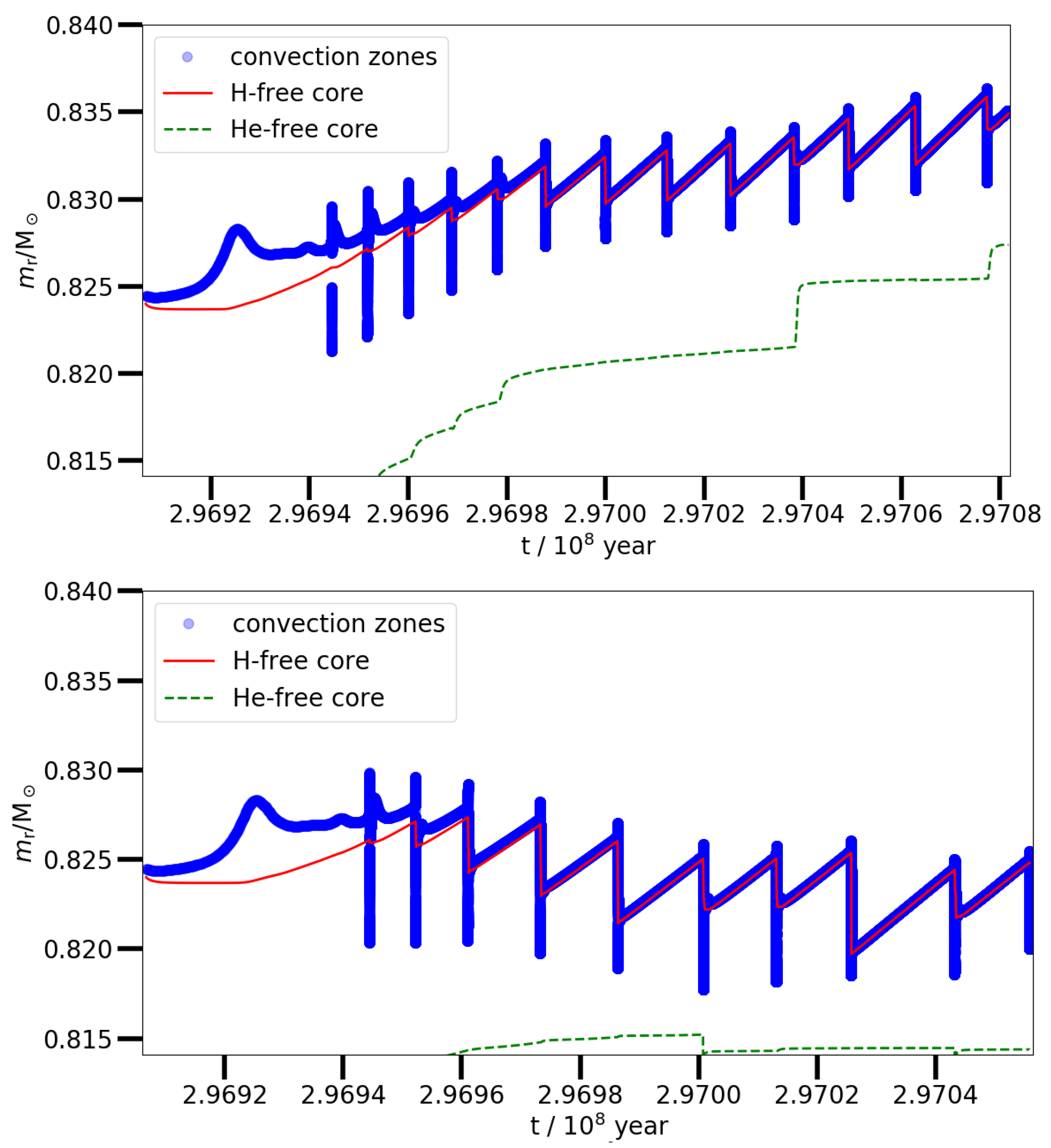

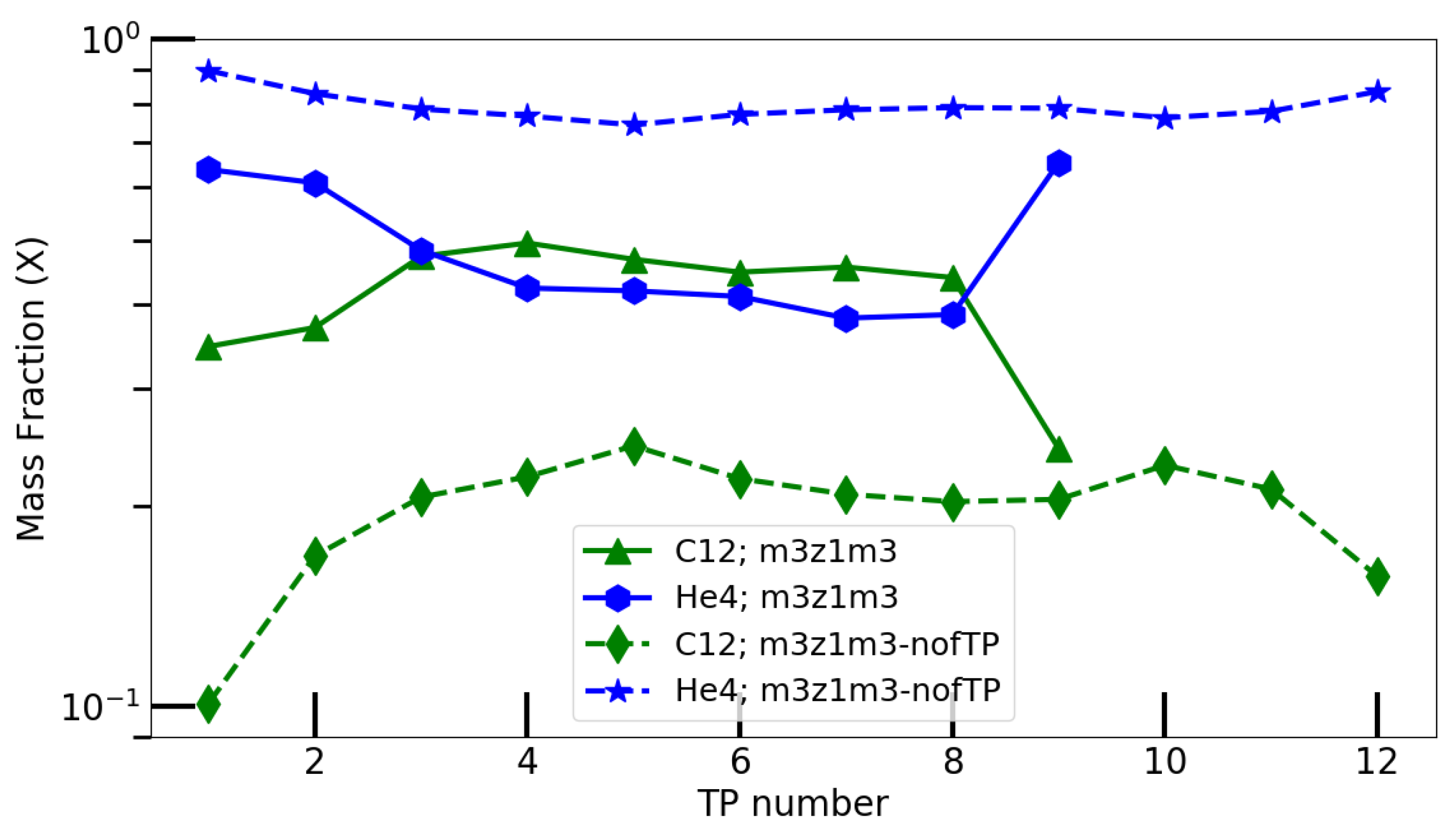
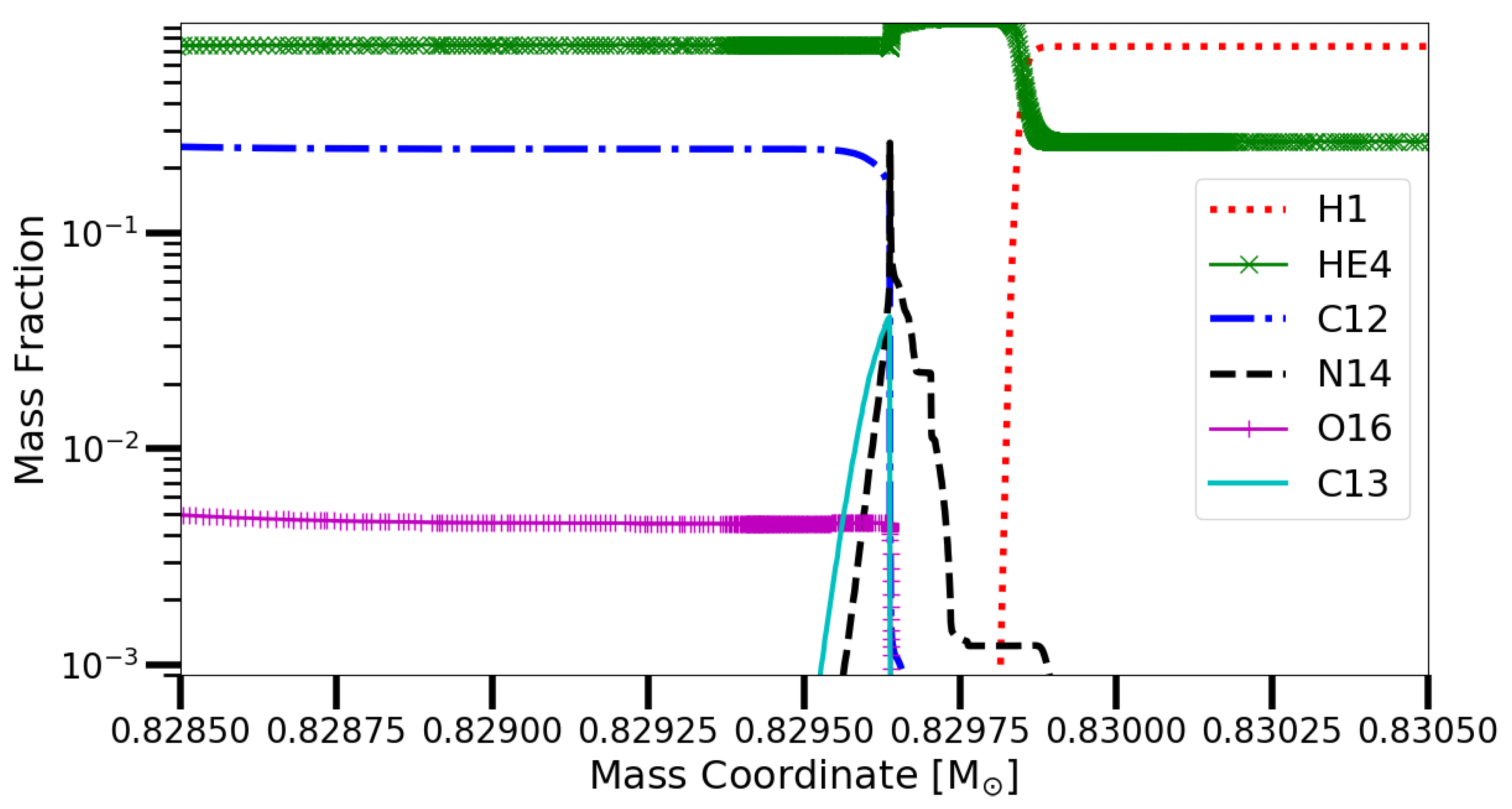
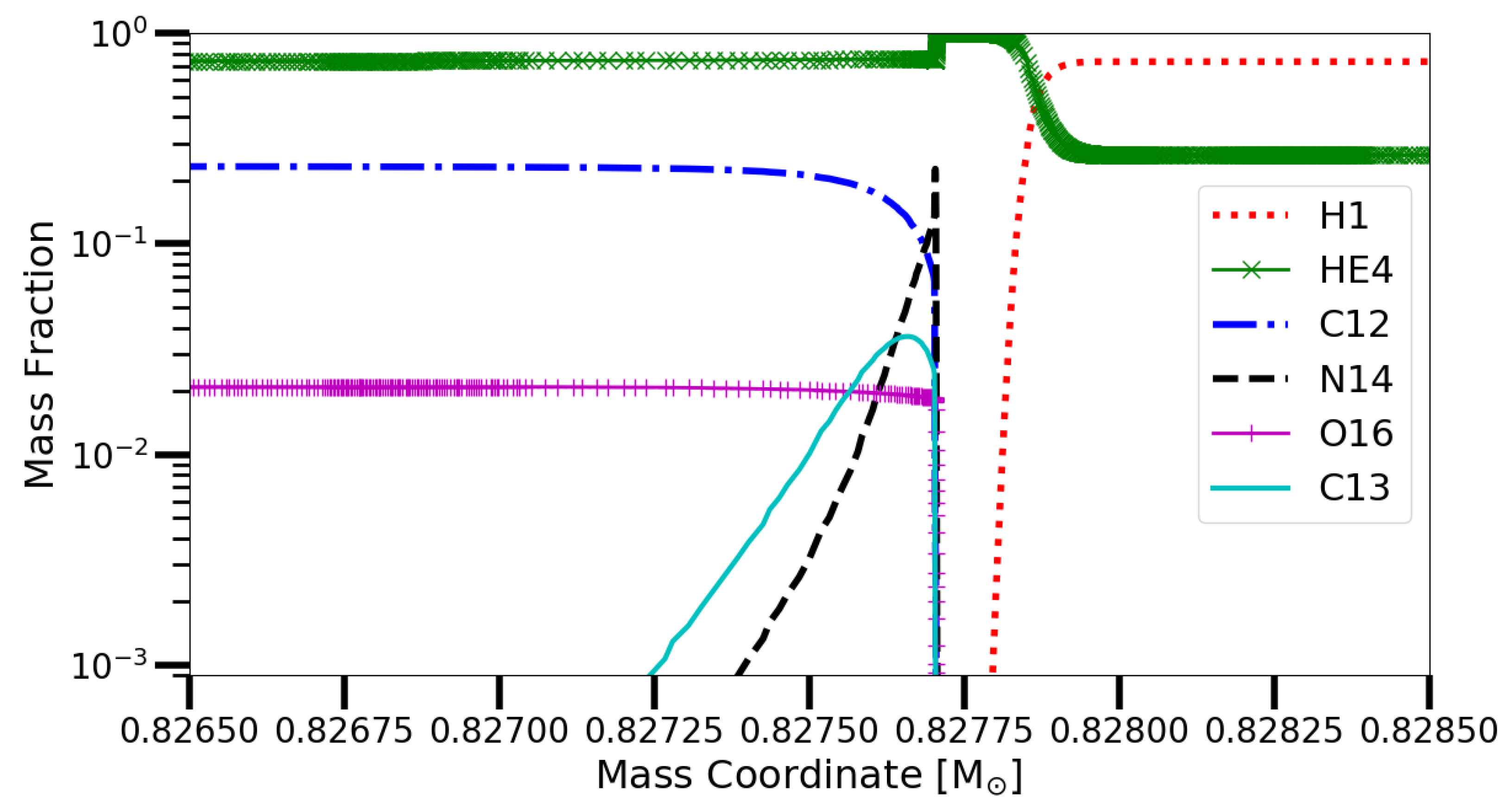
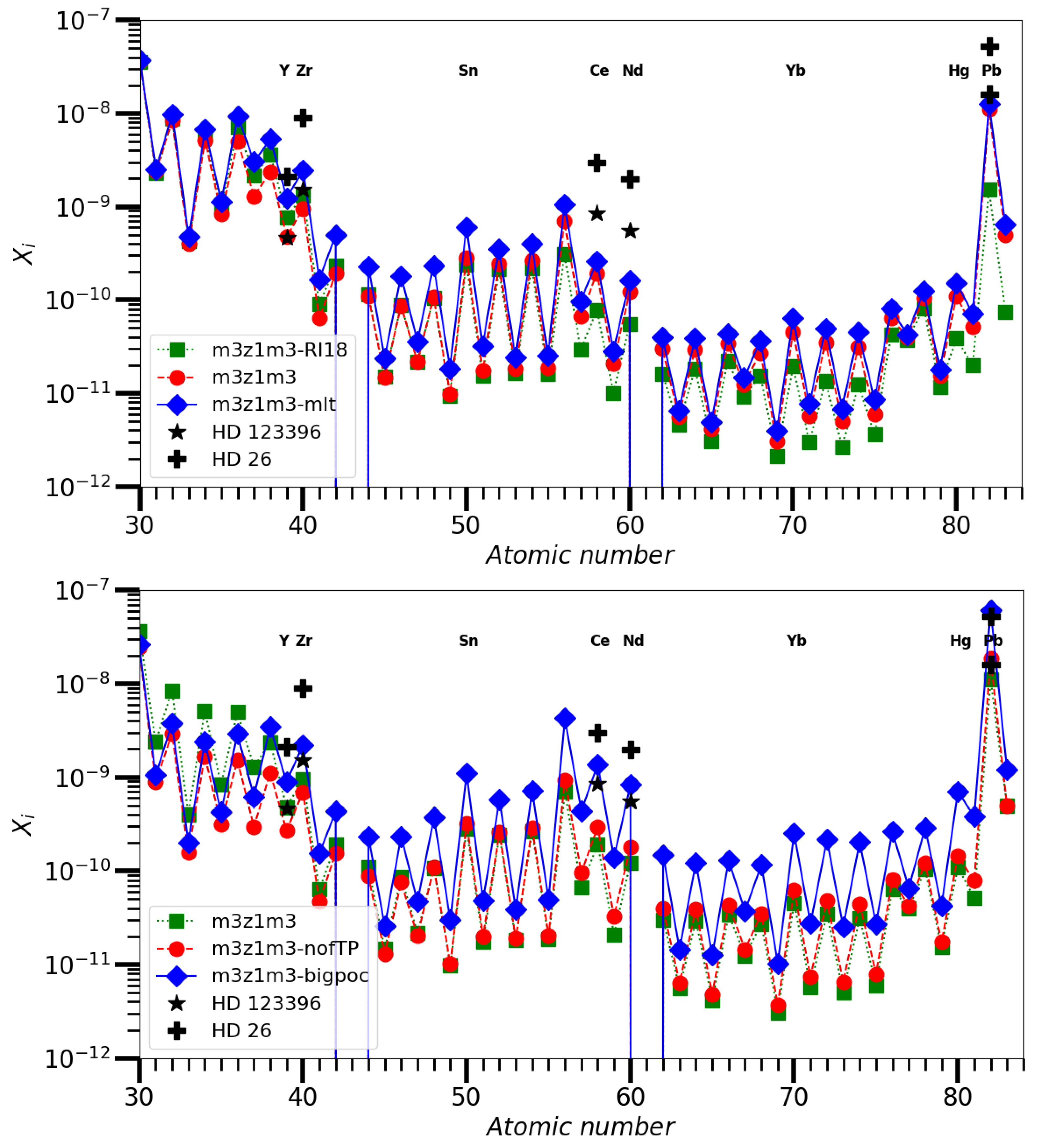
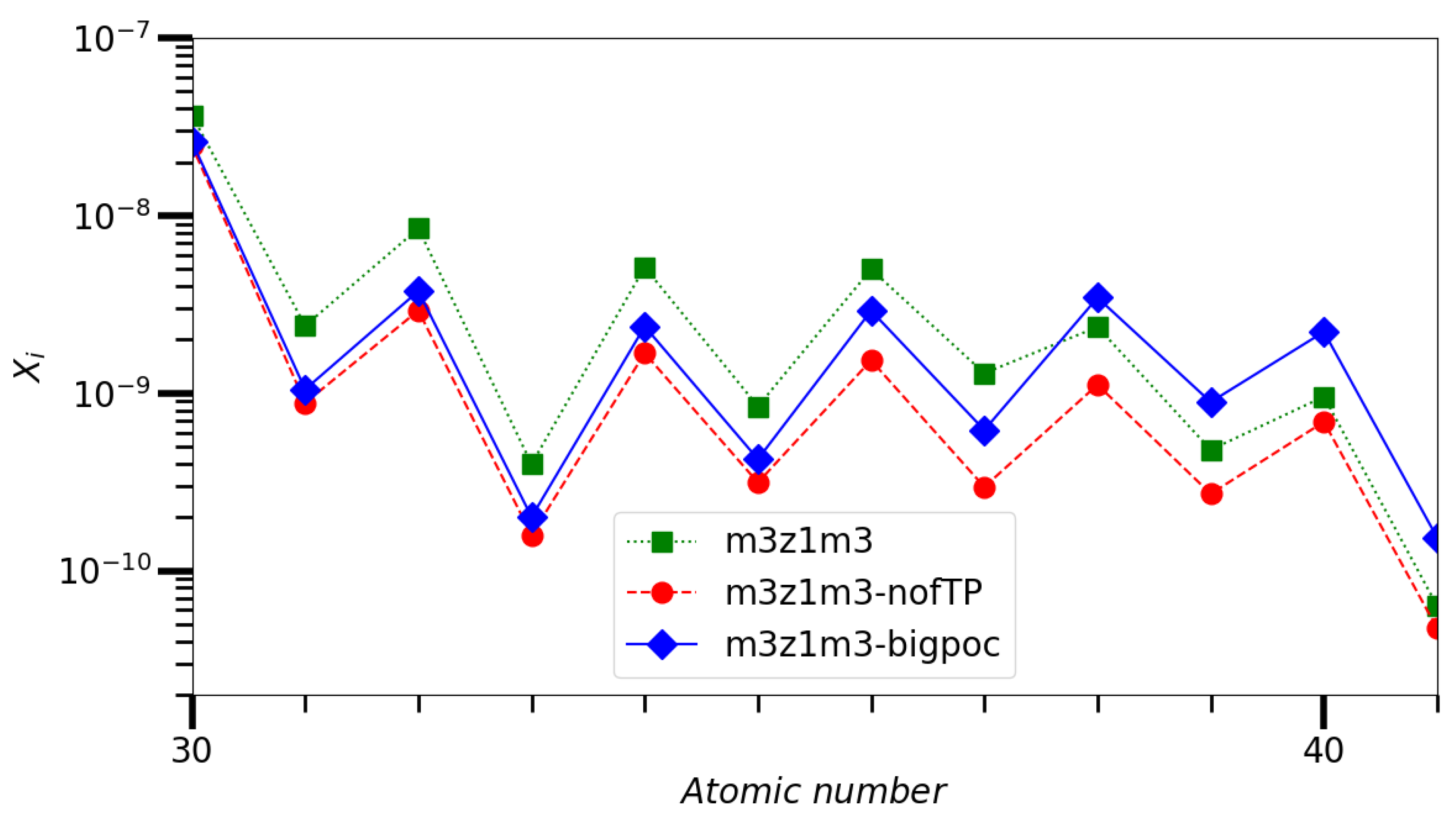
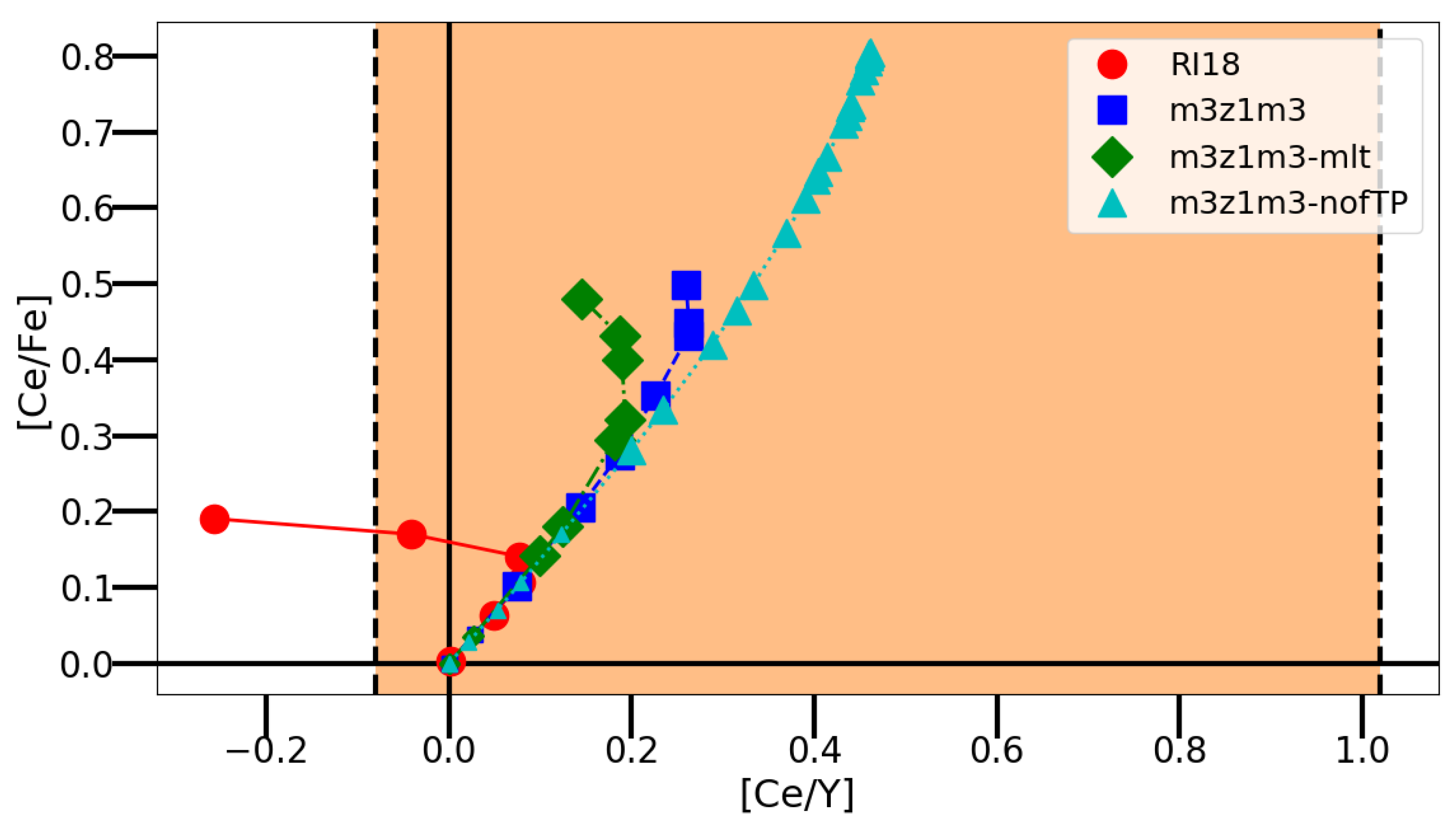

| Specie | Initial Abundance |
|---|---|
| Z = 0.001 | |
| C | |
| C | |
| N | |
| N | |
| O | |
| O | |
| O | |
| Z = 0.002 | |
| C | |
| C | |
| N | |
| N | |
| O | |
| O | |
| O | |
| Name | H-Free | H-Free | (years) | TDU | TDU | TP | |
|---|---|---|---|---|---|---|---|
| m3z1m3 | 0.826 | 0.825 | 2.97 × 10 | 0.014 | 0.27 | 0.008 | 1.73 |
| m3z2m3-mlt | 0.849 | 0.848 | 3.01 × 10 | 0.014 | 0.27 | 0.008 | 1.55 |
| m3z1m3-nofTP | 0.826 | 0.835 | 2.97 × 10 | 0.014 | 0.27 | - | 1.73 |
| m3z1m3-bigpoc | 0.826 | 0.832 | 2.97 × 10 | 0.014 | 0.50 | - | 1.73 |
| RI18 | 0.821 | 0.824 | 2.99 × 10 | 0.126 | - | 0.008 | 1.73 |
| Name | H-Free | H-Free | [years] | TDU | TDU | TP | |
|---|---|---|---|---|---|---|---|
| m2z1m3-bigpoc | 0.591 | 0.682 | 8.53 × 10 | 0.014 | 0.50 | - | 1.73 |
| m2z2m3-bigpoc | 0.558 | 0.637 | 9.27 × 10 | 0.014 | 0.50 | - | 1.73 |
| Name | [Fe/H] | Reference |
|---|---|---|
| Ba stars | ||
| HD 123396 | −1.04 | [49] |
| HD 130255 | −1.11 | [49] |
| BD+09 2384 | −0.98 | [49] |
| HD 10613 | −0.82 | [56] |
| HD 121447 | −0.90 | [58] |
| Post-AGB stars | ||
| J050632 | −1.22 | [54] |
| J052043 | −1.17 | [54] |
| J053250 | −1.22 | [54] |
| IRAS 07134 | −0.91 | [55] |
| CEMP-s stars | ||
| HD 26 | −0.98 | [50] |
Publisher’s Note: MDPI stays neutral with regard to jurisdictional claims in published maps and institutional affiliations. |
© 2021 by the authors. Licensee MDPI, Basel, Switzerland. This article is an open access article distributed under the terms and conditions of the Creative Commons Attribution (CC BY) license (http://creativecommons.org/licenses/by/4.0/).
Share and Cite
Battino, U.; Lederer-Woods, C.; Cseh, B.; Denissenkov, P.; Herwig, F. Mixing Uncertainties in Low-Metallicity AGB Stars: The Impact on Stellar Structure and Nucleosynthesis. Universe 2021, 7, 25. https://doi.org/10.3390/universe7020025
Battino U, Lederer-Woods C, Cseh B, Denissenkov P, Herwig F. Mixing Uncertainties in Low-Metallicity AGB Stars: The Impact on Stellar Structure and Nucleosynthesis. Universe. 2021; 7(2):25. https://doi.org/10.3390/universe7020025
Chicago/Turabian StyleBattino, Umberto, Claudia Lederer-Woods, Borbála Cseh, Pavel Denissenkov, and Falk Herwig. 2021. "Mixing Uncertainties in Low-Metallicity AGB Stars: The Impact on Stellar Structure and Nucleosynthesis" Universe 7, no. 2: 25. https://doi.org/10.3390/universe7020025
APA StyleBattino, U., Lederer-Woods, C., Cseh, B., Denissenkov, P., & Herwig, F. (2021). Mixing Uncertainties in Low-Metallicity AGB Stars: The Impact on Stellar Structure and Nucleosynthesis. Universe, 7(2), 25. https://doi.org/10.3390/universe7020025






